Yean Cheng
MotionBench: Benchmarking and Improving Fine-grained Video Motion Understanding for Vision Language Models
Jan 06, 2025Abstract:In recent years, vision language models (VLMs) have made significant advancements in video understanding. However, a crucial capability - fine-grained motion comprehension - remains under-explored in current benchmarks. To address this gap, we propose MotionBench, a comprehensive evaluation benchmark designed to assess the fine-grained motion comprehension of video understanding models. MotionBench evaluates models' motion-level perception through six primary categories of motion-oriented question types and includes data collected from diverse sources, ensuring a broad representation of real-world video content. Experimental results reveal that existing VLMs perform poorly in understanding fine-grained motions. To enhance VLM's ability to perceive fine-grained motion within a limited sequence length of LLM, we conduct extensive experiments reviewing VLM architectures optimized for video feature compression and propose a novel and efficient Through-Encoder (TE) Fusion method. Experiments show that higher frame rate inputs and TE Fusion yield improvements in motion understanding, yet there is still substantial room for enhancement. Our benchmark aims to guide and motivate the development of more capable video understanding models, emphasizing the importance of fine-grained motion comprehension. Project page: https://motion-bench.github.io .
DreamPolish: Domain Score Distillation With Progressive Geometry Generation
Nov 03, 2024



Abstract:We introduce DreamPolish, a text-to-3D generation model that excels in producing refined geometry and high-quality textures. In the geometry construction phase, our approach leverages multiple neural representations to enhance the stability of the synthesis process. Instead of relying solely on a view-conditioned diffusion prior in the novel sampled views, which often leads to undesired artifacts in the geometric surface, we incorporate an additional normal estimator to polish the geometry details, conditioned on viewpoints with varying field-of-views. We propose to add a surface polishing stage with only a few training steps, which can effectively refine the artifacts attributed to limited guidance from previous stages and produce 3D objects with more desirable geometry. The key topic of texture generation using pretrained text-to-image models is to find a suitable domain in the vast latent distribution of these models that contains photorealistic and consistent renderings. In the texture generation phase, we introduce a novel score distillation objective, namely domain score distillation (DSD), to guide neural representations toward such a domain. We draw inspiration from the classifier-free guidance (CFG) in textconditioned image generation tasks and show that CFG and variational distribution guidance represent distinct aspects in gradient guidance and are both imperative domains for the enhancement of texture quality. Extensive experiments show our proposed model can produce 3D assets with polished surfaces and photorealistic textures, outperforming existing state-of-the-art methods.
CogVLM2: Visual Language Models for Image and Video Understanding
Aug 29, 2024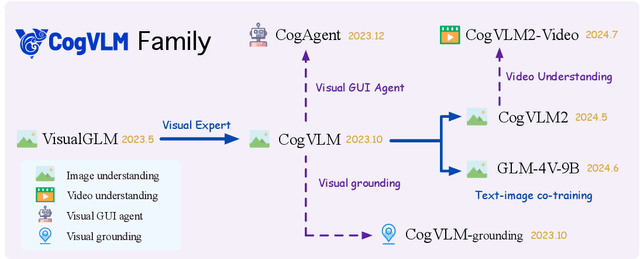

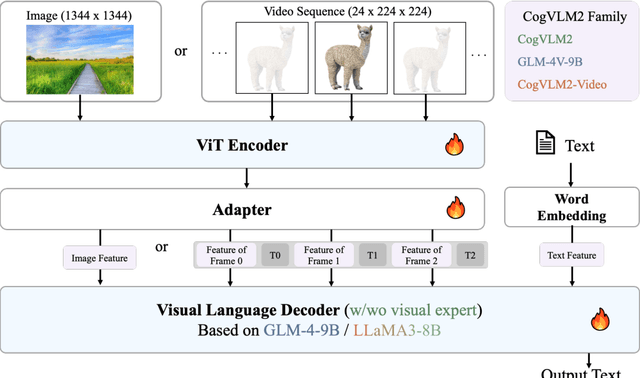
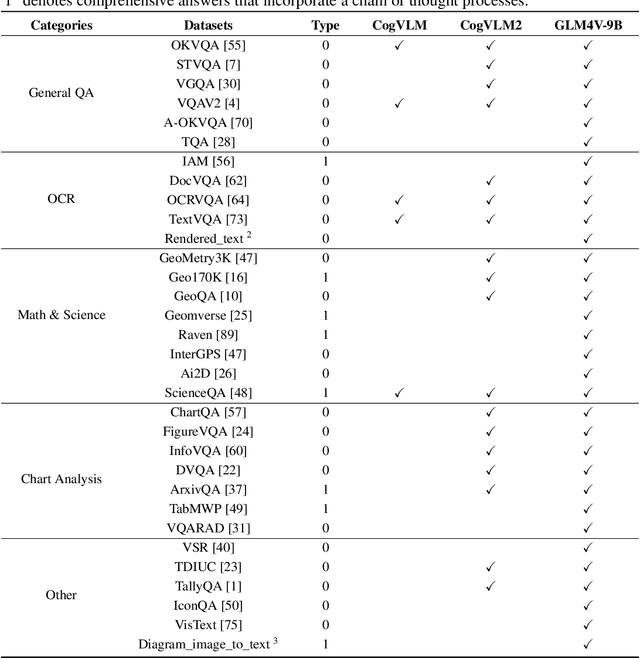
Abstract:Beginning with VisualGLM and CogVLM, we are continuously exploring VLMs in pursuit of enhanced vision-language fusion, efficient higher-resolution architecture, and broader modalities and applications. Here we propose the CogVLM2 family, a new generation of visual language models for image and video understanding including CogVLM2, CogVLM2-Video and GLM-4V. As an image understanding model, CogVLM2 inherits the visual expert architecture with improved training recipes in both pre-training and post-training stages, supporting input resolution up to $1344 \times 1344$ pixels. As a video understanding model, CogVLM2-Video integrates multi-frame input with timestamps and proposes automated temporal grounding data construction. Notably, CogVLM2 family has achieved state-of-the-art results on benchmarks like MMBench, MM-Vet, TextVQA, MVBench and VCGBench. All models are open-sourced in https://github.com/THUDM/CogVLM2 and https://github.com/THUDM/GLM-4, contributing to the advancement of the field.
CogVideoX: Text-to-Video Diffusion Models with An Expert Transformer
Aug 12, 2024Abstract:We introduce CogVideoX, a large-scale diffusion transformer model designed for generating videos based on text prompts. To efficently model video data, we propose to levearge a 3D Variational Autoencoder (VAE) to compress videos along both spatial and temporal dimensions. To improve the text-video alignment, we propose an expert transformer with the expert adaptive LayerNorm to facilitate the deep fusion between the two modalities. By employing a progressive training technique, CogVideoX is adept at producing coherent, long-duration videos characterized by significant motions. In addition, we develop an effective text-video data processing pipeline that includes various data preprocessing strategies and a video captioning method. It significantly helps enhance the performance of CogVideoX, improving both generation quality and semantic alignment. Results show that CogVideoX demonstrates state-of-the-art performance across both multiple machine metrics and human evaluations. The model weights of both the 3D Causal VAE and CogVideoX are publicly available at https://github.com/THUDM/CogVideo.
AlignMMBench: Evaluating Chinese Multimodal Alignment in Large Vision-Language Models
Jun 14, 2024Abstract:Evaluating the alignment capabilities of large Vision-Language Models (VLMs) is essential for determining their effectiveness as helpful assistants. However, existing benchmarks primarily focus on basic abilities using nonverbal methods, such as yes-no and multiple-choice questions. In this paper, we address this gap by introducing AlignMMBench, a comprehensive alignment benchmark specifically designed for emerging Chinese VLMs. This benchmark is meticulously curated from real-world scenarios and Chinese Internet sources, encompassing thirteen specific tasks across three categories, and includes both single-turn and multi-turn dialogue scenarios. Incorporating a prompt rewrite strategy, AlignMMBench encompasses 1,054 images and 4,978 question-answer pairs. To facilitate the evaluation pipeline, we propose CritiqueVLM, a rule-calibrated evaluator that exceeds GPT-4's evaluation ability. Finally, we report the performance of representative VLMs on AlignMMBench, offering insights into the capabilities and limitations of different VLM architectures. All evaluation codes and data are available on https://alignmmbench.github.io.
LVBench: An Extreme Long Video Understanding Benchmark
Jun 12, 2024



Abstract:Recent progress in multimodal large language models has markedly enhanced the understanding of short videos (typically under one minute), and several evaluation datasets have emerged accordingly. However, these advancements fall short of meeting the demands of real-world applications such as embodied intelligence for long-term decision-making, in-depth movie reviews and discussions, and live sports commentary, all of which require comprehension of long videos spanning several hours. To address this gap, we introduce LVBench, a benchmark specifically designed for long video understanding. Our dataset comprises publicly sourced videos and encompasses a diverse set of tasks aimed at long video comprehension and information extraction. LVBench is designed to challenge multimodal models to demonstrate long-term memory and extended comprehension capabilities. Our extensive evaluations reveal that current multimodal models still underperform on these demanding long video understanding tasks. Through LVBench, we aim to spur the development of more advanced models capable of tackling the complexities of long video comprehension. Our data and code are publicly available at: https://lvbench.github.io.
Colorizing Monochromatic Radiance Fields
Feb 19, 2024



Abstract:Though Neural Radiance Fields (NeRF) can produce colorful 3D representations of the world by using a set of 2D images, such ability becomes non-existent when only monochromatic images are provided. Since color is necessary in representing the world, reproducing color from monochromatic radiance fields becomes crucial. To achieve this goal, instead of manipulating the monochromatic radiance fields directly, we consider it as a representation-prediction task in the Lab color space. By first constructing the luminance and density representation using monochromatic images, our prediction stage can recreate color representation on the basis of an image colorization module. We then reproduce a colorful implicit model through the representation of luminance, density, and color. Extensive experiments have been conducted to validate the effectiveness of our approaches. Our project page: https://liquidammonia.github.io/color-nerf.
Structure-Preserving Super Resolution with Gradient Guidance
Mar 29, 2020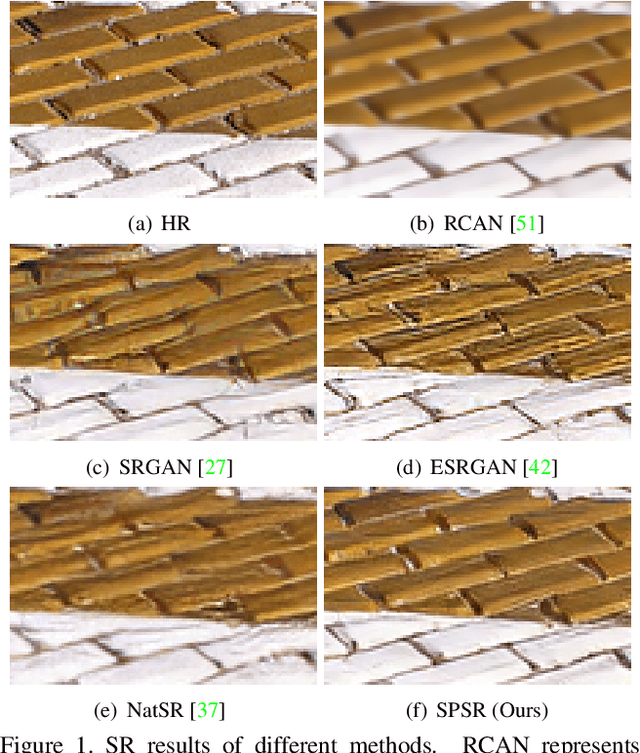
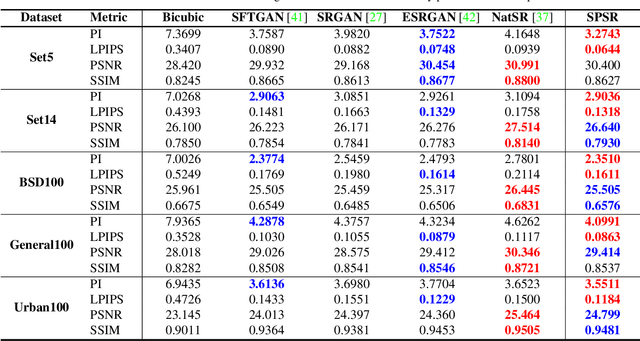
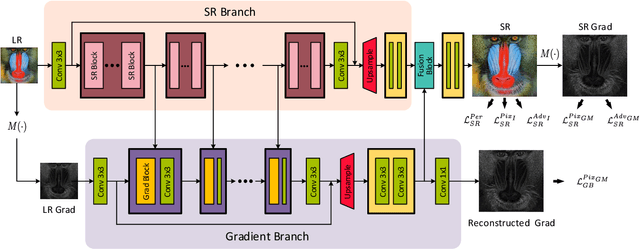

Abstract:Structures matter in single image super resolution (SISR). Recent studies benefiting from generative adversarial network (GAN) have promoted the development of SISR by recovering photo-realistic images. However, there are always undesired structural distortions in the recovered images. In this paper, we propose a structure-preserving super resolution method to alleviate the above issue while maintaining the merits of GAN-based methods to generate perceptual-pleasant details. Specifically, we exploit gradient maps of images to guide the recovery in two aspects. On the one hand, we restore high-resolution gradient maps by a gradient branch to provide additional structure priors for the SR process. On the other hand, we propose a gradient loss which imposes a second-order restriction on the super-resolved images. Along with the previous image-space loss functions, the gradient-space objectives help generative networks concentrate more on geometric structures. Moreover, our method is model-agnostic, which can be potentially used for off-the-shelf SR networks. Experimental results show that we achieve the best PI and LPIPS performance and meanwhile comparable PSNR and SSIM compared with state-of-the-art perceptual-driven SR methods. Visual results demonstrate our superiority in restoring structures while generating natural SR images.
 Add to Chrome
Add to Chrome Add to Firefox
Add to Firefox Add to Edge
Add to Edge